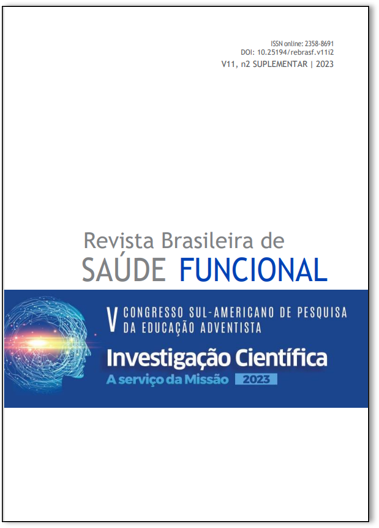HEALTH PERCEPTION OF MEN EMPLOYEES OF A PRIVATE INSTITUTION
AN EXPERIENCE REPORT.
DOI:
https://doi.org/10.25194/rebrasf.v11i2.1665Keywords:
Health Education; Man; Work; Intervention.Abstract
Introduction: Health is essential for the quality of life of human beings, and its maintenance is equally important. Faced with this fact, human well-being has become a global concern, given that this is a population that rarely monitors its health status. Men are more likely to be more vulnerable to acquiring diseases than women. This is due to a high exposure to behavioral risk conditions in addition to cultural aspects that are related to gender stereotypes, supporting the thesis that men do not value prevention practices and health care. Objective: To report the experience of students in the 6th period of the Nursing course at Faculdade Adventista da Bahia (FADBA) when carrying out a university extension intervention related to the perception of health of male workers at a private institution. Description of the experience: This report was experienced in the Professional Development Project (PDP) module of the Faculdade Adventista da Bahia, in association with the Adult Health module, related to men's health, aiming to understand the low demand for health services by this group as well how to promote health education. The participants in this study are nursing students along with the teaching and guiding nurse. For the educational activities, the active teaching-learning methodology was used. Conclusion: The dialogue spaces favored the development of scientific research. In addition, the rapprochement between students and society also allowed the expansion of knowledge about the perspective of men on their health. This experience made it possible to qualify the academic-professional training in the field of health education, and its multiplication is important to strengthen the interaction between professionals and the articulation of health actions.
References
Araújo, Marley Rosana Melo de, e Kátia Regina Santos de Morais. “Precarização Do Trabalho E O Processo de Derrocada Do Trabalhador.” Cadernos de Psicologia Social do Trabalho, PEPSIC, vol. 20, não. 1, 2017, pp. 1–13,pepsic.bvsalud.org/scielo.php?script=sci_arttext&pid=S151637172017000100001Acesso em: 23 ago. 2021.
Pnad Contínua Anual - Educação - 2019 - IMB.” Www.imb.go.gov.br, www.imb.go.gov.br/index.php?option=com_content&view=article&id=2262:pnad-continua-anual-educacao-2019&catid=118&Itemid=284. Acesso em: nov. 2021.
Sistema de Informação Sobre Mortalidade – SIM (1979 a 2020) - OPENDATASUS.” Opendatasus.saude.gov.br, opendatasus.saude.gov.br/dataset/sim-1979-2019. Acesso em: 23 ago. 2021
IBGE | Comitê de Estatísticas Sociais | Base de Dados | Metadados | Ministério Da Saúde | Sistema de Informações Hospitalares Do Sus – SIH/SUS. Ces.ibge.gov.br, ces.ibge.gov.br/base-de-dados/metadados/ministerio-da-saude/sistema-de-informacoes-hospitalares-do-sus-sih-sus.html#:~:text=A%20finalidade%20do%20AIH%20(Sistema. Acesso em: 30 ago. 2021
Chaves, Jéssica Bazilio, et al. “Saúde Masculina: O Paralelo Prevenção X Cuidado à Luz Da Teoria Da Ação Planejada (TAP).” Saúde E Pesquisa, vol. 11, no. 2, 30 Aug. 2018, pp. 315–324, periodicos.unicesumar.edu.br/index.php/saudpesq/article/view/6360, https://doi.org/10.17765/1983-1870.2018v11n2p315-324.
Czorny, Rildo César Nunes, et al. “Perfil Do Usuário Homem Atendido Em Uma Unidade Básica de Saúde Da Família.” Rev. Enferm. UFPE on Line, 2017, pp. 1624–1631, pesquisa.bvsalud.org/portal/resource/pt/bde-31208. Acesso em: 30 ago. 2021.
Da Rocha, Joseane, et al. “Assistência Integral a Saúde Do Homem: Necessidades, Obstáculos E Estratégias de Enfrentamento Integral Assistance to Men’s Health: Needs, Barriers and Coping Strategies Asistencia Integral a La Salud Del Hombre: Necesidades, Obstáculos Y Estrategias de Afrontamiento PESQUISA | RESEARCH.” Escola Anna NEry REvista de EnfErmagEm, vol. 18, no. 4, p. 2014, www.scielo.br/pdf/ean/v18n4/1414-8145-ean-18-04-0628.pdf, https://doi.org/10.5935/1414-8145.20140089.
Schraiber, Lilia Blima, et al. “Necessidades de Saúde E Masculinidades: Atenção Primária No Cuidado Aos Homens.” Cadernos de Saúde Pública, vol. 26, 1 May 2010, pp. 961–970, www.scielo.br/j/csp/a/WqZXnfzQcY7FW5ycMfzvjjM/?lang=pt, https://doi.org/10.1590/S0102-311X2010000500018. Acesso em: 16 nov. 2021.
Ministério, D, and Saúde. Dados de Morbimortalidade Masculina No Brasil.Disponível em: https://bvsms.saude.gov.br/bvs/folder/dados_morbimortalidade_masculina_brasil.pd. Acesso em: 16 ago. 2021.


